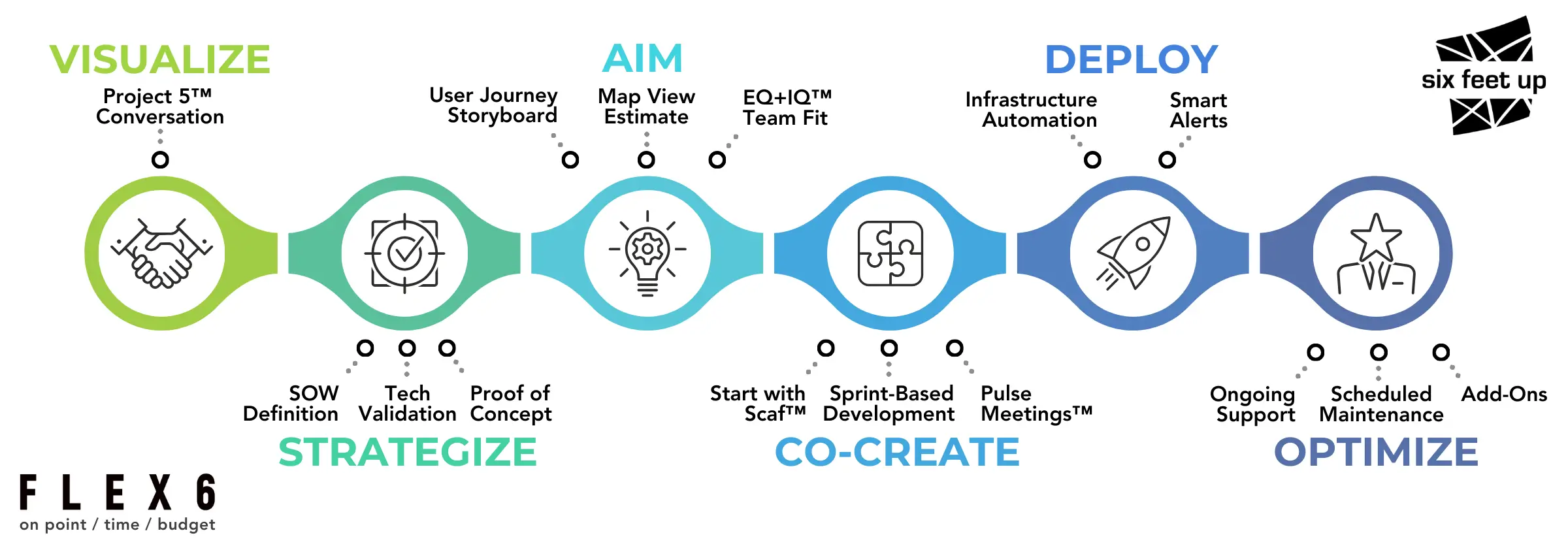Developed over the course of 25+ years, our Flex6™ process is designed to deliver projects on time and on budget, all the while creating meaningful and positive relationships with project stakeholders.

01. VISUALIZE
Before jumping into technology decisions, we begin by understanding your destination. Our Project 5™ Conversation is a strategic discussion with our CTO examining the five critical elements of your project: success definition, constraints, expertise requirements, timeline, and funding parameters. This foundational step ensures we're the right partner for your journey or allows us to connect you with better-suited alternatives.
Schedule your complimentary Project 5™ meeting now >
02. STRATEGIZE
After confirming partnership alignment, we develop a comprehensive SOW Definition that precisely captures your objectives, success metrics, timeline milestones, and budget parameters.
We then conduct Tech Validation to assess and confirm the optimal technology stack for your specific needs. For acquisition scenarios, we provide pre-investment technological due diligence, cutting through marketing hype to deliver fact-based assessments of digital assets through code reviews and expert evaluation.
When business viability needs verification, we create a targeted Proof of Concept that drives informed go/no-go decisions. These POCs demonstrate both the potential and limitations of proposed solutions, providing stakeholders with tangible evidence for strategic decision-making.
03. AIM
After establishing your strategic direction, we zero in on precise targets for success with our multi-faceted AIM phase.
We begin with the creation of a high-level User Journey Storyboard through collaborative sessions with stakeholders and end users. This visual mapping process transforms abstract requirements into a clear, actionable development pathway that everyone can understand and align with.
Using this storyboard as our foundation, we develop a detailed Map View Estimate that projects both effort and investment required. This isn't merely a calculation—it's an informed forecast backed by nearly three decades of software development expertise. Each estimate undergoes rigorous peer review to account for all potential variables and considerations.
With approved plans in hand, we deploy our proprietary EQ+IQ™ Team Fit evaluation to assemble your ideal engineering team. This unique approach matches not just technical skills and industry experience, but also personality traits and individual interests to create a high-performing team specifically tailored to your project's requirements.
04. CO-CREATE
At the heart of our methodology lies a deeply collaborative development approach that transforms ideas into robust, secure software through our CO-CREATE phase.
We launch new projects with our proprietary Start with Scaf™ blueprint—a foundation that ensures architectural consistency, accelerates development, and maintains rigorous quality standards from day one.
Our Sprint-Based Development process embraces agility and transparency. Working in focused increments, we continuously refine user stories alongside stakeholders and showcase tangible progress through regular demonstrations. This cadence creates natural feedback loops, keeping you intimately connected to the evolution of your product.
Communication remains paramount through our renowned Pulse Meetings™—weekly touchpoints where we analyze progress against budget, address emerging challenges, and answer questions. These structured interactions, backed by our 5-Star Guarantee, encourage the candid feedback essential for exceptional outcomes.
Throughout development, your project benefits from our comprehensive security protocols and engineering excellence: daily standups that leverage our Collective Wisdom, atomic commits, integrated testing, thorough code reviews, and rigorous validation. We implement multi-layered security measures including principle-based access controls, careful secrets management, and automated vulnerability detection.
The CO-CREATE phase transforms vision into reality through structured collaboration, combining your domain expertise with our technical mastery to build solutions that truly deliver on your business objectives.
05. Deploy
The DEPLOY phase moves your project from development to production with precision and reliability through our proven deployment approach.
Our Infrastructure Automation tools create the foundation for successful deployments. We use Infrastructure as Code to build consistent, secure environments that meet compliance standards. Container orchestration simplifies how we manage and scale your applications, while our source code management keeps track of all changes and resolves conflicts automatically.
We implement continuous integration to automate important processes like building, testing, and security scanning—reducing manual errors and helping you deploy faster without sacrificing quality.
We keep an eye on your systems with our Smart Alerts practices. These monitoring techniques use practical filtering and thoughtful escalation thresholds to notify you about what really matters, avoiding alert overload while ensuring important issues get immediate attention.
For each deployment, we maintain a Mission Control approach with experts ready to jump in if needed, ensuring smooth transitions to production.
After launch, we hold a straightforward 360° Retrospective—a chance to celebrate wins, note what we've learned, and improve our process for next time.
06. OPTIMIZE
After deployment, we continue to enhance and refine your software system through our OPTIMIZE phase, offering three key service categories tailored to your ongoing needs.
Ongoing Support provides responsive assistance for day-to-day operational needs, addressing questions, resolving issues, and ensuring your systems run smoothly. Whether you need regular help or occasional troubleshooting, our team is ready to provide the expertise you need.
Scheduled Maintenance delivers proactive care through systematic updates, security patches, performance tuning, and preventative measures. These planned engagements help extend your application's lifespan while maintaining optimal efficiency and security posture.
Add-Ons allow your software to evolve alongside your business needs. We can implement new features, integrate additional systems, expand functionality, or enhance user experiences.
To deliver these services effectively, we offer three flexible engagement models:
- Project Work - Ideal for organizations needing at least 50 hours of work.
- On-Demand Support - A flexible option requiring no commitment, offering both urgent support (under 8 business hours) and scheduled support (over 8 business hours) based on team availability.
- Emergency Support - Our premium service guaranteeing two-hour response times during business hours with after-hours contact options, providing peace of mind for mission-critical systems.

